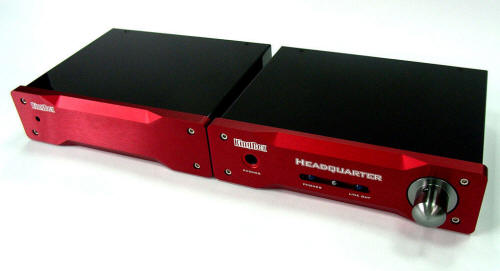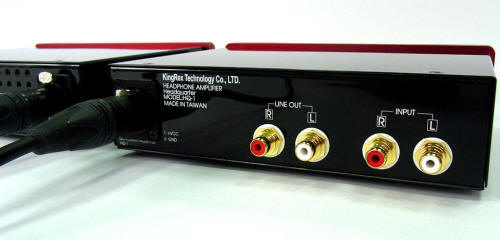|
You are reading the older HTML site Positive Feedback ISSUE 47january/february 2010
KingRex HQ-1 or
"Headquarters" Amp Just when you thought it was safe to go back into your listening room, here's another headphones amp review from yours truly. Can users, rejoice! The KingRex HQ-1 headphones amp is very minimalist in controls having only an on/off switch, a volume control, and a switch that allows the user to select phones or line-out. Don't let that stop you. All the good stuff is inside two half-sized boxes; one, the linear power supply; the other, the solid state audio circuitry. Together they add up to a surprisingly superior product at its price point, for a headphones amp designed and manufactured by KingRex in Taipei Taiwan, about whom you can learn more at www.kingrex.net. There, amidst very strong test results, is the magic combination of qualities that have almost always predicted excellent performance: wide-band, flat frequency response; low distortion; and low noise. I did not see anything mentioning rise-time, but my ear-test suggests it must be pretty fast. (The folks at KingRex use MOS Fets in its output and they do not yet have the instrumentation to measure rise-time.) When I substituted the HQ-1 (MSRP $889) for my highly regarded Parasound JC-2 preamp (MSRP $4000) in my big system I heard very little fall-off in performance, so I assume the two preamps might have a similar performance profile. Of course, in a one source system (say, a CD player), you won't need a lot of inputs and switching capability, balanced outputs, and remote control. In my system, in my room, through my ears, I'd say the HQ-1 performs at a pretty damn high level driving headphones or a free-standing system.
I recently reviewed the tubed Mini-Amp (see PFO Issue 46 at https://positive-feedback.com/Issue46/miniwatt.htm), manufactured by Mini-Watt of Hong Kong, and I mention it because I think both these products have received a disproportionate amount of engineering skill on their respective power supplies. (By the way, Minnie and HQ-1 sound great together through my Lowther C45s, creating that certain synergy that tubes plus transistors sometimes find.) From this sample of two can I make a general statement? Theoretically, no. But bearing that in mind, I'll ask a question: Is this the beginning of a trend? Is this the beginning of truly high-end performance power supplies at mid-fi price points? I hope so!! The term "mid-fi" is usually derogatory, and aimed at modestly performing gear. Here, I mean to note a nearly "mid-fi" price that competes with "hi-end" performance. In short, the KingRex HQ-1 'phones amp competes with gear twice its price, and more. For comparison's sake, I'll mention that I have in-house both the very smooth Grado battery-powered, portable RA-1 phones amp; and the even smaller, a tad more detailed Ray Samuels' battery-fed "The Hornet." I also have the very "bloomy and beautiful" Single Power tubed amp (with on-board supply), the "Slam, PP X-3;" and the overall very high-performing HeadRoom Desktop Millett Hybrid Amp (transistorized front end, tubed output stage) which I listen to with either a separate switching supply for rock, or a linear supply for classical music. This gives me a spread of different design types, power supplies, power sources, solid-state, tubes, and half-and-half. I mention these because you will likely have had some experience with one or another of the various types along the path of your audio quest, and the above gives my thumbnail sketch of each. I hope these sketches touch the significant differences that might prove helpful. A little typology review seems in order: Battery power-supplies are attractive because they eliminate the power-supply transformer, the rectifier (which converts AC house current to DC), and the regulators (that set the voltage from approx. 120 VAC to whatever voltage the design calls for). The power supply (in any amplifier or pre-amp) has to be very quiet and is usually built with a transformer that often weighs as much (and costs as much) as everything else combined. Battery-supplies cost significantly less and are inherently quieter, much quieter. Unfortunately, they have short life spans for big system use, and they are inconvenient. Happily, as they are quiet and relatively cheap, they make for portability that makes them great for air-travel and beach listening. Battery power-supplies are a favorite with frequent fliers and sun-worshipers in portable amps to be used with ear-buds or collapsible 'phones.
At the King Rex website, you can see the photo of the HQ-1 linear power-supply, with its large torus (doughnut) shaped transformer, and you can read how no expense is spared in parts selection in this standard transformer-and-capacitor type "linear design." Similarly the photo of the circuit chassis reveals very top level parts in the signal path section of the design. Together, as you might expect, the performance has a synergistic effect where the combined interaction is an improvement over the mere sum of its parts. (It is funny how a good designer can aim for synergy.) The HQ-1 must be a well-designed piece. How does it sound? Compared to my HeadRoom Desktop Millett Hybrid Amplifier, which has been my favorite for a few years now and, to my taste, does everything well; and through Grado PS-1000, their new flagship 'phones; the KingRex HQ-1 provides some exciting improvements: more extended highs, tighter bass, less veiled and nearly as beautiful mid-range. But, one might point out, that is what we'd expect from a well-executed tube circuit as compared to a well-executed transistor circuit. To which I'd reply; I agree, but the MSRP of the Millett amp, with class A input circuitry, a stepped-attenuator volume-control, and a switching power-supply (for increased punch) came to about $1150 or more. I have to say, these differences are not "jump out at you" kinds of things: they are, rather, as though graphing them on logarithmic scale paper where the smallest difference can take up a misleading large space. Such a comparison is analogous to examining a blue-print with a magnifying glass, which reveals the smallest of differences, and presents them as more important than they are. The HQ-1 is very subject to variation in interconnect cables, AC cords, and the pit-tail from the power supply to the amplifier. As I've said before, some of what were thought to be performance characteristics of the circuitry turn out to be characteristics of the various hookup wires, cables, etc., and upgrading them is a way of voicing systems and headphones. For a few examples: in the Telarc SACD of Prokofief's Romeo and Juliet Suites there are some passages where the bass drum is not "banged" but "rolled" with two mallets. Some headphone amps blur the separate and distinct mallet hits into one long tone, something like a sustained organ pedal tone. Through the HQ-1, the distinct but fast hits are clearly separate and the hall's decay/resonance effects produce something like rolling thunder. I like to use the term "bass texture" for this quality, the ability to separate the individual mallet strikes from a sustained tone of the same frequency. In my experience, much of this improvement is brought about by a "stiffer" power-supply and/or cabling. Similarly, the tambourine is a good instrument for judging high frequency texture performance. Sometimes in Romeo and Juliet the tambourine is struck on the leather creating a "pop" and a simultaneous "sizzle" of the miniature cymbals fixed to its wooden frame. Other times the player will "rattle" the instrument so only the cymbals' sizzle comes into play. Sometimes the rattle will be sustained over periods while the orchestra plays on: other times, the rattle will coincide with a start and stop pattern in the score. The HQ-1, which is biased to Class A operation, is able to differentiate all these moments, and reproduces them with high resolution. There is no extra and unwanted sibilance, which would prolong the sizzle and obscure the clarity, which (if we could watch a slo-mo film of an oscilloscope's traces of the music as it changes) we might think of as "tracer bullets." This form of distortion is caused by ringing at various frequencies. This freedom from ringing, I think it is agreed, is brought about by including the highest audio-quality passive parts (resistors, capacitors, inductors) in the design. Avoiding excess sibilance brings out what we have come to call "delicacy," or the retrieval of low-level detail in the mix. Ringing is noticeable by its absence from the mid-range, as well. The old tube circuits had over-much "bloom" that some folks liked because it made some instruments and human voices seem "richer and fuller." Today's power supplies and improved parts have limited the bloom even in all-tube gear. The old solid state circuits had over-much "damping" that some folks liked because it kept the bass from being "wooly" and human voices from being exaggeratedly rich. It seems the HQ-1 'phones amp has again found the right voicing on the bloom/damping continuum. I'm not sure how this damping factor is tuned. It can range from between 20-50 units for a modern tube amp, to over 1,000 units of damping factor for transistorized amps. I think this is determined, to some degree, by a little circuit near the output tap that controls the reverse electro-motive force reflected back to an amplifier by the drivers to which it's connected. To some extent, theory is only a rough guide, and "ear-testing" might be the final "tuning method" before it is released to the public. In any event, the HQ-1 has it noticeably "just right." The HQ-1 has accurate voicing. By "voicing" I mean, when various instruments (trumpet, clarinet, saxophone, violin, harpsichord, piano) play the same note in the same register, we can tell which note comes from which instrument by the partial harmonic overtones of each. The trumpet is brassy, the clarinet is woody, the saxophone reedy; the violin is a bowed string instrument, the harpsichord is plucked, the piano hammered, and there is little confusing one for another. All this is nearly immediately discernable through the HQ-1, while it isn't quite as quickly sorted out by some other amps (and what my wife laughingly calls my "brain"). For another example, the saxophone is given a fairly prominent place by Prokofiev in his Romeo and Juliet Suites, and depending on where and how it's used, is a bit of a surprise because so few classical composers use the saxophone. It is always immediately clear, to me, when the saxophone is used, even briefly. Praise to the folks at KingRex! Their designer has seen to it that HQ-1 has very low phase distortion (that I can hear), which seems to correlate to voicing error. So how the HQ-1 sounds is almost without fault. I guess I like it fine with classical music, though it is also gang-busters with rock, and my favorite album lately is Roadhouses & Automobiles by Chris Jones. It has excellent audio-engineering; fine detail, natural sounding voices, extraordinary dynamic range, and ferocious low frequencies. Look for it on Amazon. It's a killer. I think it was the last of Chris Jones's work, who died early (age 46) of lung cancer, and dedicated one sardonic song to the tobacco companies. All the songs are suffused with the sadness of a man who knows he's dying. If you can put up with that kind of poetry, don't miss it. Back to the HQ-1: One thing is the stock AC cable that brings the current from the wall. It's not bad, but the power supply is very sensitive to any AC noise. I'd recommend a good, after-market AC cable. I had the blue (least expensive, Oxygen-free-copper) Wireworld "Stratus" cable in play for a while, and it cleaned up considerable stuff the stock cord left in. Then I tried Wireworld's second best silver-clad over Ohno continuous cast copper, and it became two notches (or more) cleaner and detailed. I know this adds to the purchase price, but you might try it. Once you hear what such cables do, you'll be a convert. So take this as a warning. Another thing: The manufacturer recommends that the HQ-1 sounds a lot better after about 300 hours of continuous "burning in." So, before you listen, or immediately after it arrives and you put it through its paces with albums you know quite well, and have taken notes on its performance—"base-line data" here—then put a 24/7 signal through it, perhaps a portable FM radio, and let it play for two weeks or more, and listen again while taking notes. Same thing with the various AC cords you might have lurking around. My advice: beware of listening too loudly; consider all the best cabling you can afford; and burn the amp in with an FM tuner, and with a spare pair of headphones as the load. You don't have to play it very loudly to get all the copper molecules to "form" optimally. OK, it's time to sum up. The KingRex HQ-1 is another surprisingly big-bang/low-bucks product coming in from the mysterious East. Its specs catch the eye and its performance catches the ear. The price is pretty reasonable for such a first class performer, the most telling descriptor of which is "clarity." Some other words that describe the characteristics of its sound might be quiet, airy, spacious, hi-rez, humongous bass, lottsa zotz (startleability) and clean, clean, clean. If you are interested in this great sounding, if minimalist, approach to a headphones amplifier, check www.kingrex.net for their U.S. dealer network. This is Max Dudious signing off. Ciao Bambini.
KingRex Technology Co., LTD.
|



